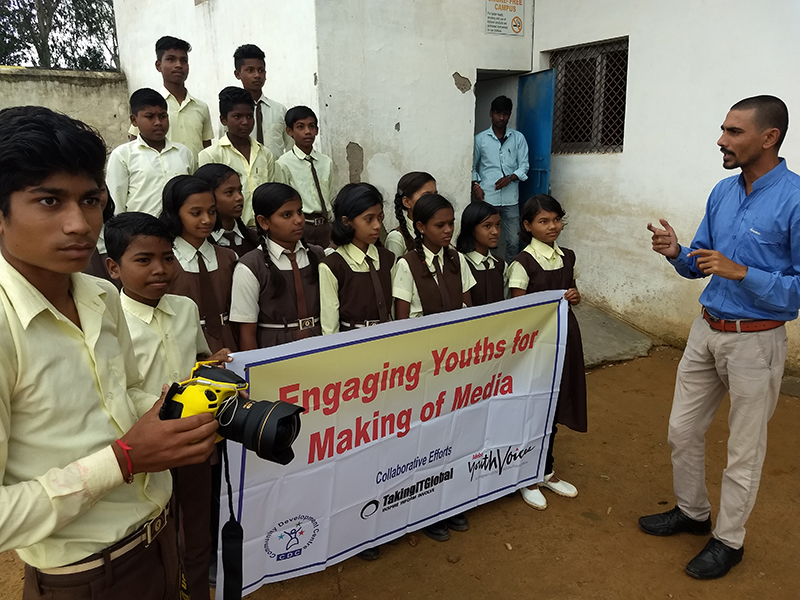The Community Development Centre




Grant Period: One year
Our decision to make grants to schools came from the realisation that this would provide opportunities for the entire school to integrate their arts education programme, bring the various stakeholders together, and connect local arts and cultural practices and community knowledge systems to classroom pedagogies. It is within this context that the first grant under the call for proposals from nonprofit schools across the country has been made to Utkarsh Vidhyalaya run by The Community Development Centre (CDC) in Garhi village of Baihar Block in Balaghat district of Madhya Pradesh. It will enable year-long activities with the school as the anchor, bringing together the community and other civic groups to establish and enhance language arts education for students. The project seeks to create stronger ties between the students, the school and community members.
The villages around Garhi are inhabited mainly by people of the Baiga and Gond communities with a small population of Yadavs. The knowledge system of these communities is local and oral. Their skills traditionally lie in intimate knowledge of plants and animals. They speak a language which is referred to as Baiga-Boli and is recognised to be a form of Chhattisgarhi, with some connections to Marathi and Hindi. In school the medium of instruction is Hindi, which is quite different from it, making it unfamiliar to the children.
Members of these communities prior to 1977 stayed in the core zone of the Kanha forest and were dependent on its resources. After their relocation they were finding it tough to adapt to new ways of life when CDC intervened to help them. In 2004, CDC started Utkarsh Vidhyalaya a school up to grade 8th at Garhi village. The core intention of establishing the school was to provide good education to children from Gond and Baiga communities.
While India is a multicultural and a multilingual society with multiple religions and castes, the whole educational system, including the curriculum, the text books, the reading material, the educational goals and the management system, is focused on non-tribal middle class urban population which, ethnocentrically is called the 'main stream'. Since the tribals are expected to gradually join the 'main stream', education for them is conceived as a mechanism to enable them in this process. Therefore the incongruity between educational system catering to the 'main stream' culture, and the culture of the tribals is rarely noticed. In many cases home language is different from the school language in spite of the fact that policies in education emphasise early education in mother tongue or regional language. This makes a large number of languages endangered and some that are slowly becoming extinct. This is also a significant factor for low participation of tribals in the educational process.
The primary purpose of this project is to explore the significance of language documentation and to consider the linguistic and extra-linguistic factors which impact the learning abilities of young students. It focuses on pedagogy that is directly supported by documentation. This is a collaborative project with members of the Gond and Baiga dialect-speaking community of Garhi and neighbourhood villages. The basic approach will be to develop and operationalise a system of crafting learning resources that arises organically from the Baiga and Gond communities.
The project will create a pedagogical grammar and meanings dictionary for school teachers. It will include definitions in Gondi, Baiga, Hindi and English with example sentences, text references, and reverse lookups in these languages. It will take a word-centered approach such that teachers can look up fully inflected words they come across in texts and find complete definitions. In addition, morphologically complex words will include a parse line that cross-references the individual pieces. It will also outline few specific suggestions for teachers who are not fluent speakers from Gondi and Baiga communities but however want to teach for communicative competence. It will have questions and answers that encourage interaction and negotiation in the Baiga-Boli language.
Ameen Charles, co-coordinator and the founder member of CDC feels that education is meaningless unless local perspectives are brought into practice. He plans a series of discussions with community members, teachers and senior students in their own language to enable the students to explore the layered meanings of their language text. Activities for the students will involve observing and recording, journaling, discussions, lectures, field trips, interviews, and reading about their own communities. Alongside these activities, the school will also organise workshops for teachers and students with scholars, writers and community members. They will invite artists and scholars to create a platform for dialogue between students, teachers and parents. The materials the children create from these experiences will be put up in an exhibition. With these activities the project aims to connect learning within and outside the school; culture at school and culture at home; and the home to the world outside.
The outcomes from this project will include the dictionary in Hindi-Gondi-English, which will be shared with other cluster schools where children of the community study and an exhibition of the materials created by the children. There will also be performances of Gond and Baiga dances in a festival organised by the school for the community.
The deliverables from the project to IFA along with the final report will be a copy of the dictionary, and photographs and video documentation of the exhibition and performances.
This grant is part-supported by Infosys Foundation.
